air conditioning TOYOTA SIENNA HYBRID 2021 (in English) Owner's Manual
[x] Cancel search | Manufacturer: TOYOTA, Model Year: 2021, Model line: SIENNA HYBRID, Model: TOYOTA SIENNA HYBRID 2021Pages: 601, PDF Size: 32.07 MB
Page 355 of 601
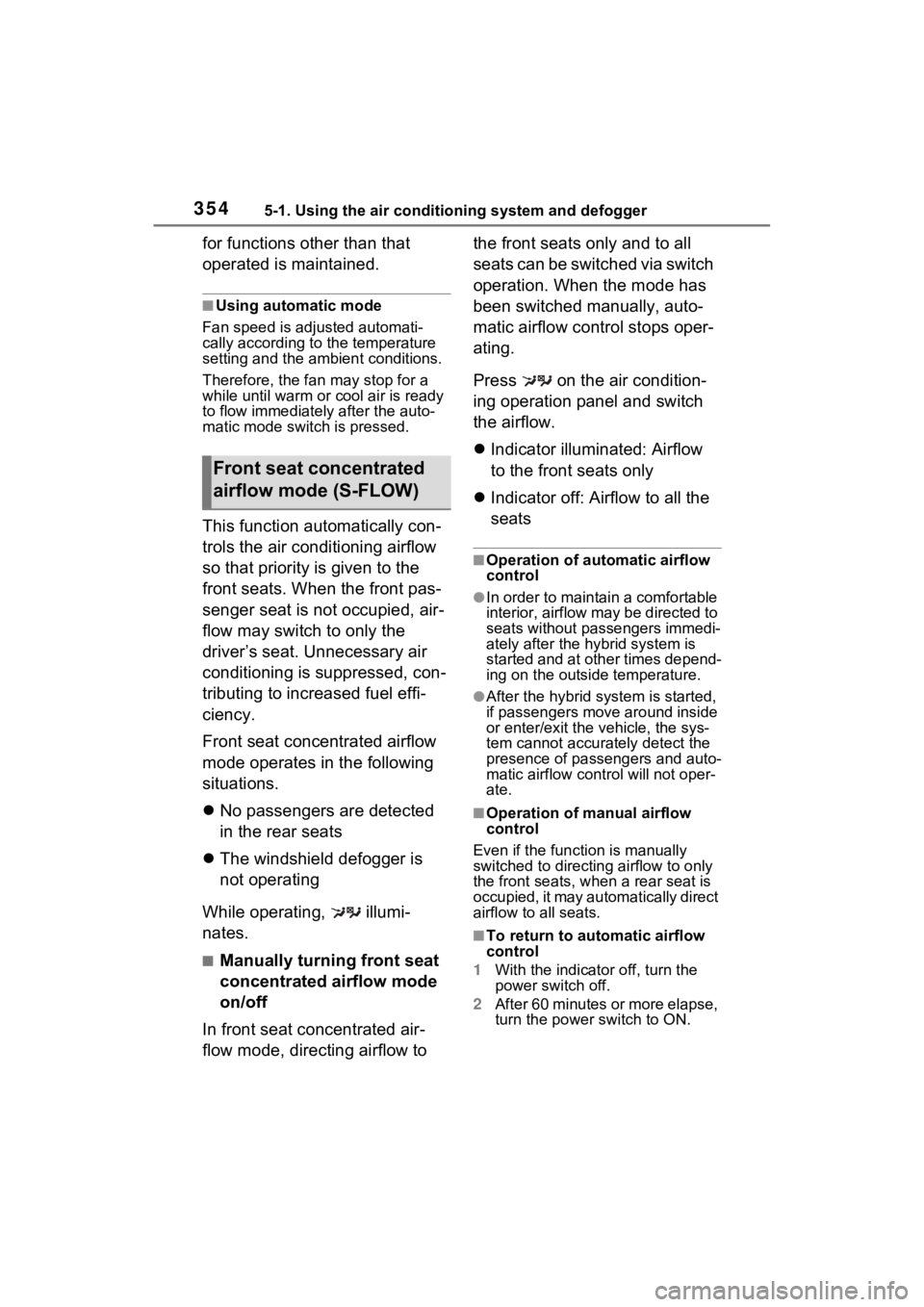
3545-1. Using the air conditioning system and defogger
for functions other than that
operated is maintained.
■Using automatic mode
Fan speed is adjusted automati-
cally according to the temperature
setting and the ambient conditions.
Therefore, the fan may stop for a
while until warm or cool air is ready
to flow immediately after the auto-
matic mode switch is pressed.
This function automatically con-
trols the air conditioning airflow
so that priority is given to the
front seats. When the front pas-
senger seat is not occupied, air-
flow may switch to only the
driver’s seat. Unnecessary air
conditioning is suppressed, con-
tributing to increased fuel effi-
ciency.
Front seat concentrated airflow
mode operates in the following
situations.
No passengers are detected
in the rear seats
The windshield defogger is
not operating
While operating, illumi-
nates.
■Manually turning front seat
concentrated airflow mode
on/off
In front seat concentrated air-
flow mode, directing airflow to the front seats only and to all
seats can be switched via switch
operation. When the mode has
been switched manually, auto-
matic airflow control stops oper-
ating.
Press on the air condition-
ing operation panel and switch
the airflow.
Indicator illuminated: Airflow
to the front seats only
Indicator off: Airflow to all the
seats
■Operation of automatic airflow
control
●In order to maintain a comfortable
interior, airflow may be directed to
seats without passengers immedi-
ately after the hybrid system is
started and at other times depend-
ing on the outside temperature.
●After the hybrid system is started,
if passengers move around inside
or enter/exit the vehicle, the sys-
tem cannot accura tely detect the
presence of passengers and auto-
matic airflow co ntrol will not oper-
ate.
■Operation of manual airflow
control
Even if the funct ion is manually
switched to directing airflow to only
the front seats, w hen a rear seat is
occupied, it may automatically direct
airflow to all seats.
■To return to automatic airflow
control
1 With the indicator off, turn the
power switch off.
2 After 60 minutes or more elapse,
turn the power switch to ON.
Front seat concentrated
airflow mode (S-FLOW)
Page 356 of 601
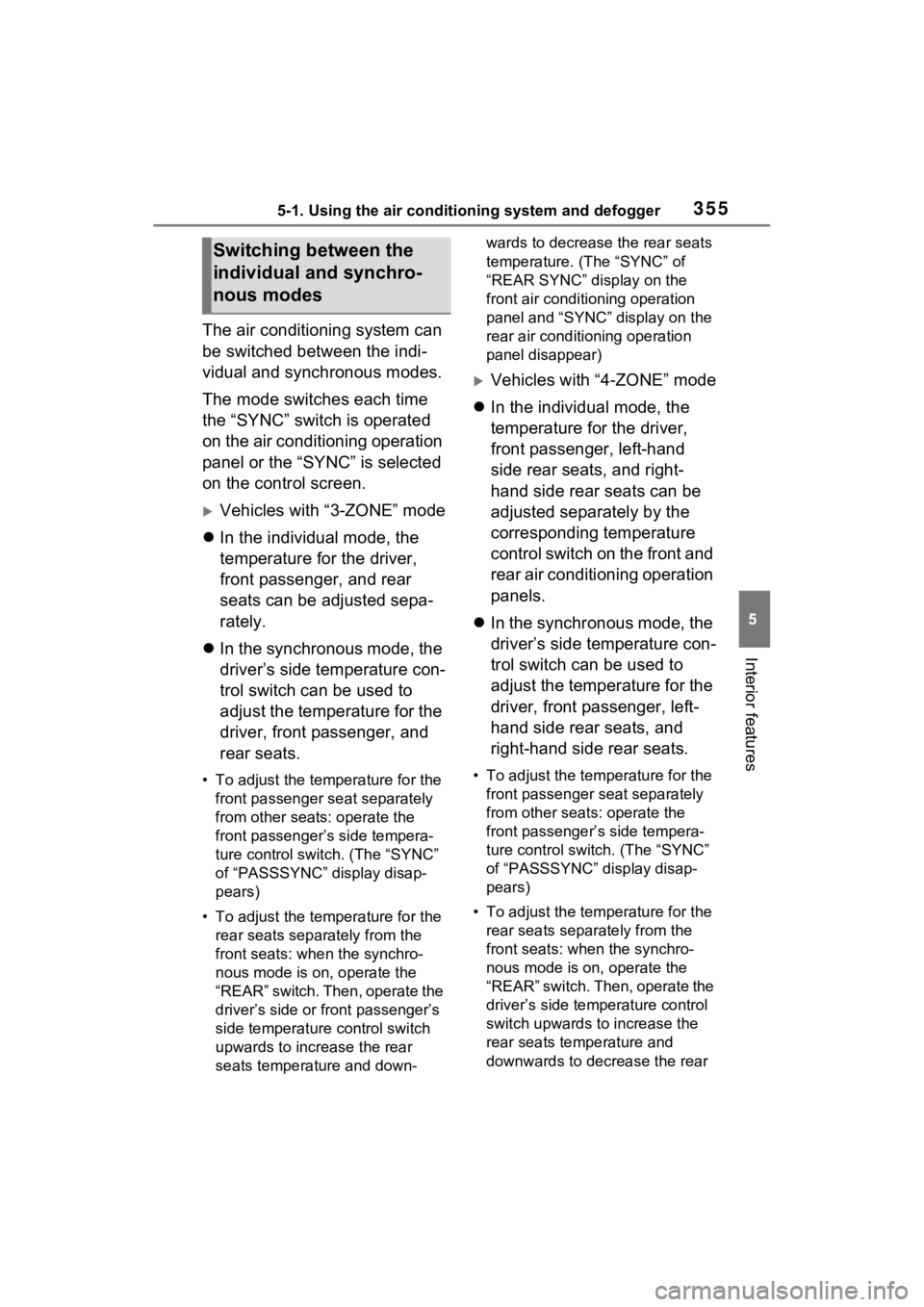
3555-1. Using the air conditioning system and defogger
5
Interior features
The air conditioning system can
be switched between the indi-
vidual and synchronous modes.
The mode switches each time
the “SYNC” switch is operated
on the air conditioning operation
panel or the “SYNC” is selected
on the control screen.
Vehicles with “3-ZONE” mode
In the individual mode, the
temperature for the driver,
front passenger, and rear
seats can be adjusted sepa-
rately.
In the synchronous mode, the
driver’s side temperature con-
trol switch can be used to
adjust the temperature for the
driver, front passenger, and
rear seats.
• To adjust the temperature for the
front passenger seat separately
from other seats: operate the
front passenger’s side tempera-
ture control switch. (The “SYNC”
of “PASSSYNC” display disap-
pears)
• To adjust the temperature for the rear seats separately from the
front seats: when the synchro-
nous mode is on , operate the
“REAR” switch. Then, operate the
driver’s side or front passenger’s
side temperature control switch
upwards to increase the rear
seats temperature and down- wards to decrease the rear seats
temperature. (The “SYNC” of
“REAR SYNC” display on the
front air conditioning operation
panel and “SYNC” display on the
rear air conditioning operation
panel disappear)
Vehicles with “4-ZONE” mode
In the individual mode, the
temperature for the driver,
front passenger, left-hand
side rear seats, and right-
hand side rear seats can be
adjusted separately by the
corresponding temperature
control switch on the front and
rear air conditioning operation
panels.
In the synchronous mode, the
driver’s side temperature con-
trol switch can be used to
adjust the temperature for the
driver, front passenger, left-
hand side rear seats, and
right-hand side rear seats.
• To adjust the temperature for the
front passenger s eat separately
from other seats: operate the
front passenger’s side tempera-
ture control switch. (The “SYNC”
of “PASSSYNC” display disap-
pears)
• To adjust the temperature for the rear seats separately from the
front seats: when the synchro-
nous mode is on, operate the
“REAR” switch. Then, operate the
driver’s side temperature control
switch upwards to increase the
rear seats temperature and
downwards to decrease the rear
Switching between the
individual and synchro-
nous modes
Page 357 of 601

3565-1. Using the air conditioning system and defogger
seats temperature. (The “SYNC”
of “REAR SYNC” display on the
front air conditioning operation
panel disappears)
To adjust the temperature for the
right-hand side rear seats sepa-
rately from the left-hand side rear
seats, operate the passenger’s
side temperature control switch.
(The “SYNC” of “RIGHT SYNC”
display on the rear air condition-
ing operation panel disappears)
• To adjust the temperature for the driver’s seat and passenger’s
seat separately from the rear
seats: when the synchronous
mode is on, operate the passen-
ger’s side temperature control
switch to adjust t he front passen-
ger’s seat temperature. Then
operate the “REAR” switch, and
operate the driver’s side tempera-
ture control switch to adjust the
rear seats temperature. (The
“SYNC” of “REAR SYNC” display
and the “SYNC” of “PASSSYNC”
display on the front air condition-
ing operation panel disappear)
To adjust the temp erature for the
driver’s seat, operate the “REAR”
switch again and operate driver’s
side temperature switch.
Operate the “REAR” switch.
The modes between the rear air
conditioning system and the front
air conditioning system switches
each time the “REAR” switch is
operated.
The air conditioning system switches between
individual and
synchronous modes each time the
“SYNC” switch is operated.
( P.355)
If the system is left untouched for
approximately 6 seconds after
changing to the rear air condition-
ing system, the control mode in the
front control pane l returns to the
front.
Adjusting the temperature
setting
Vehicles with “3-ZONE” mode
Operate the driver’s or passen-
ger’s side temperature control
switch upwards to increase the
temperature and operate the
switch downwards to decrease
the temperature.
Vehicles with “4-ZONE” mode
Operate the passenger’s side
temperature control switch to
adjust the right-hand rear seats
temperature, and operate the
driver’s side temperature control
switch to adjust the left-hand
side rear seats temperature.
Operate the temperature con-
trol switch upwards to increase
the temperature and operate the
switch downwards to decrease
the temperature.
Fan speed setting
Operate the fan speed control
switch upwards to i ncrease the fan
speed and downwards to decrease
the fan speed.
Touch the “OFF” swit ch to turn the
fan off.
Changing the rear seat
settings (if equipped)
Page 358 of 601
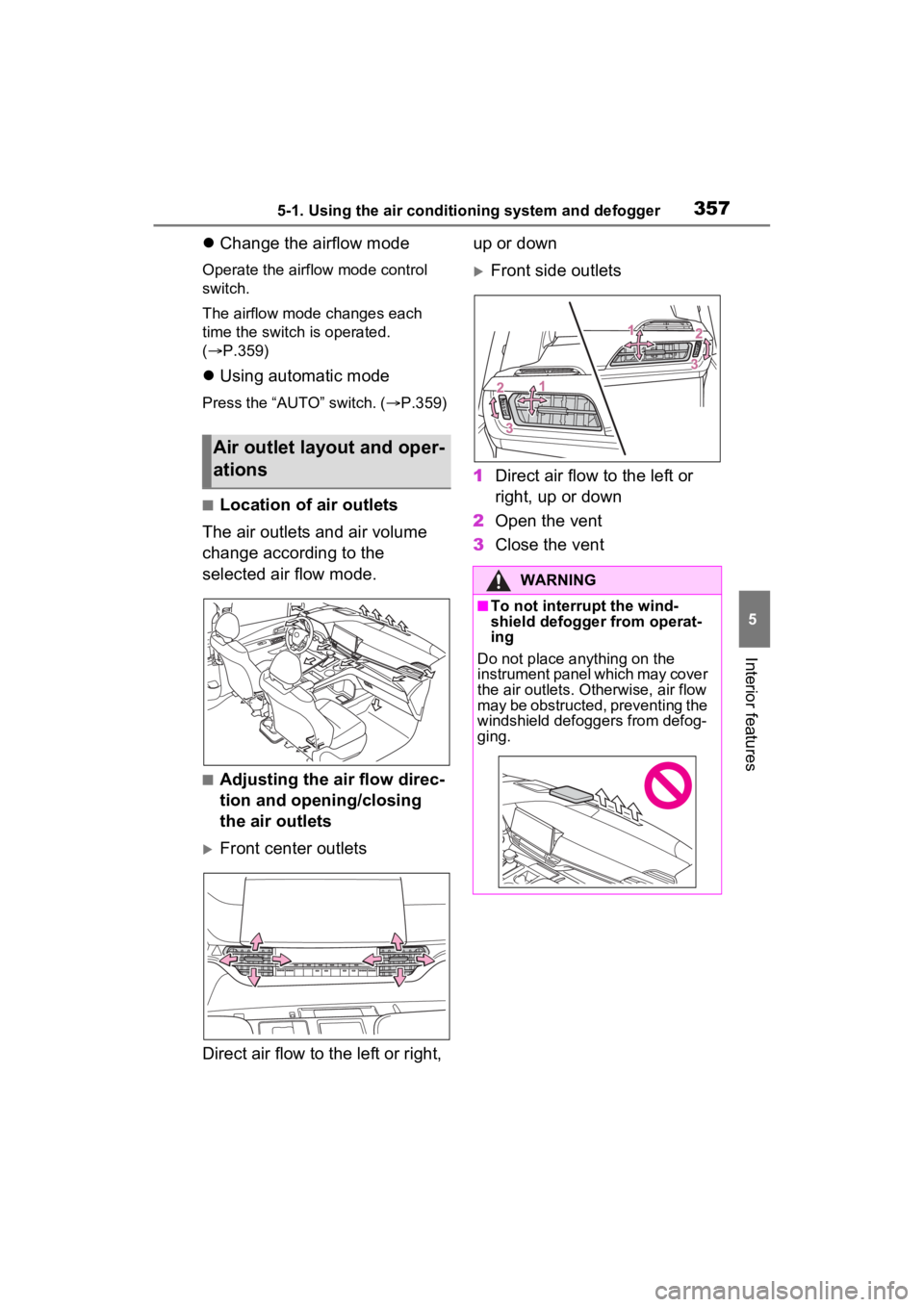
3575-1. Using the air conditioning system and defogger
5
Interior features
Change the airflow mode
Operate the airflow mode control
switch.
The airflow mode changes each
time the switch is operated.
( P.359)
Using automatic mode
Press the “AUTO” switch. ( P.359)
■Location of air outlets
The air outlets and air volume
change according to the
selected air flow mode.
■Adjusting the air flow direc-
tion and opening/closing
the air outlets
Front center outlets
Direct air flow to the left or right, up or down
Front side outlets
1 Direct air flow to the left or
right, up or down
2 Open the vent
3 Close the vent
Air outlet layout and oper-
ations
WARNING
■To not interrupt the wind-
shield defogger from operat-
ing
Do not place anything on the
instrument panel which may cover
the air outlets. Otherwise, air flow
may be obstructed, preventing the
windshield defoggers from defog-
ging.
Page 359 of 601
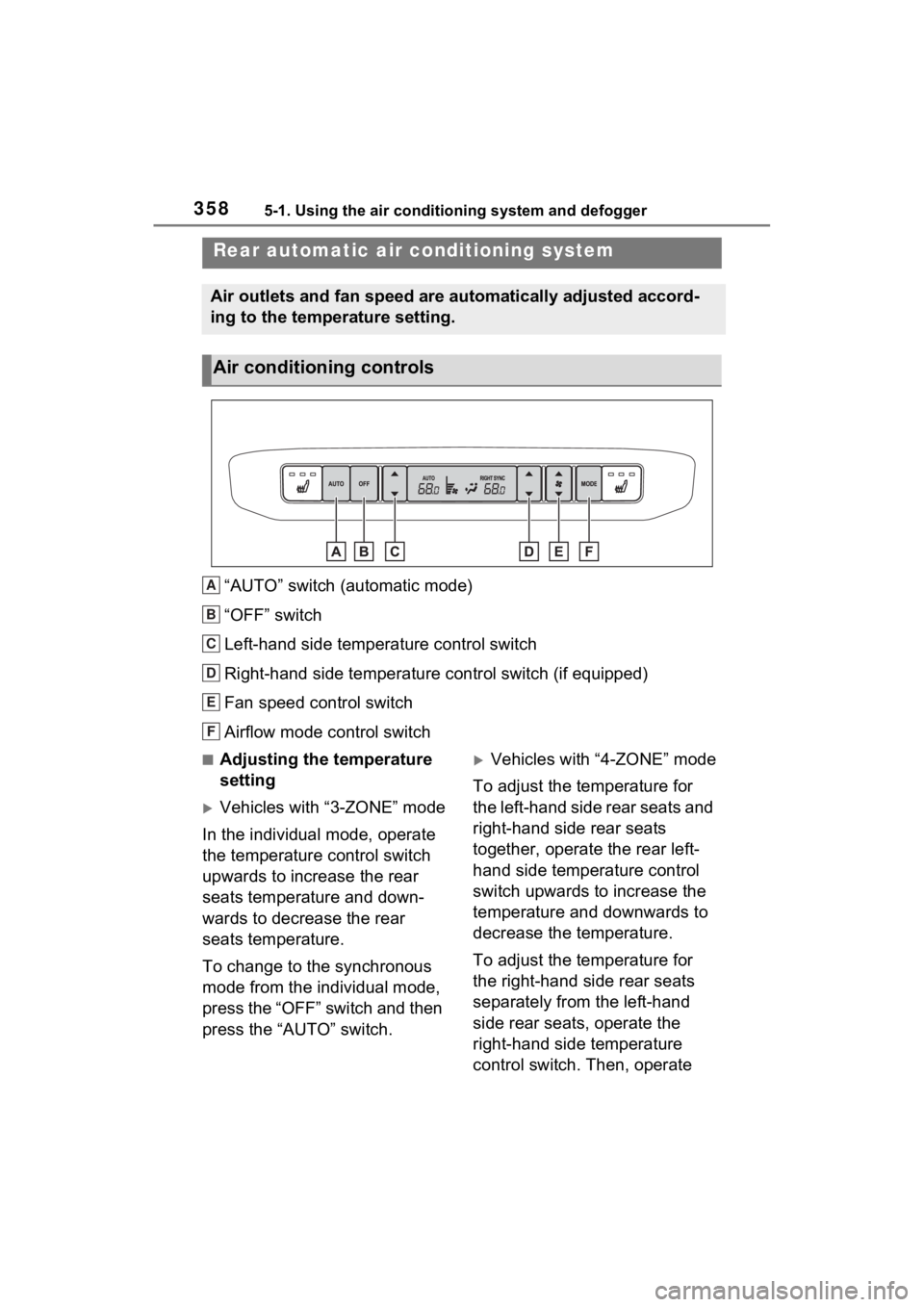
3585-1. Using the air conditioning system and defogger
“AUTO” switch (automatic mode)
“OFF” switch
Left-hand side temperature control switch
Right-hand side temperature control switch (if equipped)
Fan speed control switch
Airflow mode control switch
■Adjusting the temperature
setting
Vehicles with “3-ZONE” mode
In the individual mode, operate
the temperature control switch
upwards to increase the rear
seats temperature and down-
wards to decrease the rear
seats temperature.
To change to the synchronous
mode from the individual mode,
press the “OFF” switch and then
press the “AUTO” switch.
Vehicles with “4-ZONE” mode
To adjust the temperature for
the left-hand side rear seats and
right-hand side rear seats
together, operate the rear left-
hand side temperature control
switch upwards to increase the
temperature and downwards to
decrease the temperature.
To adjust the temperature for
the right-hand side rear seats
separately from the left-hand
side rear seats, operate the
right-hand side temperature
control switch. Then, operate
Rear automatic ai r conditioning system
Air outlets and fan speed are automatically adjusted accord-
ing to the temperature setting.
Air conditioning controls
A
B
C
D
E
F
Page 360 of 601
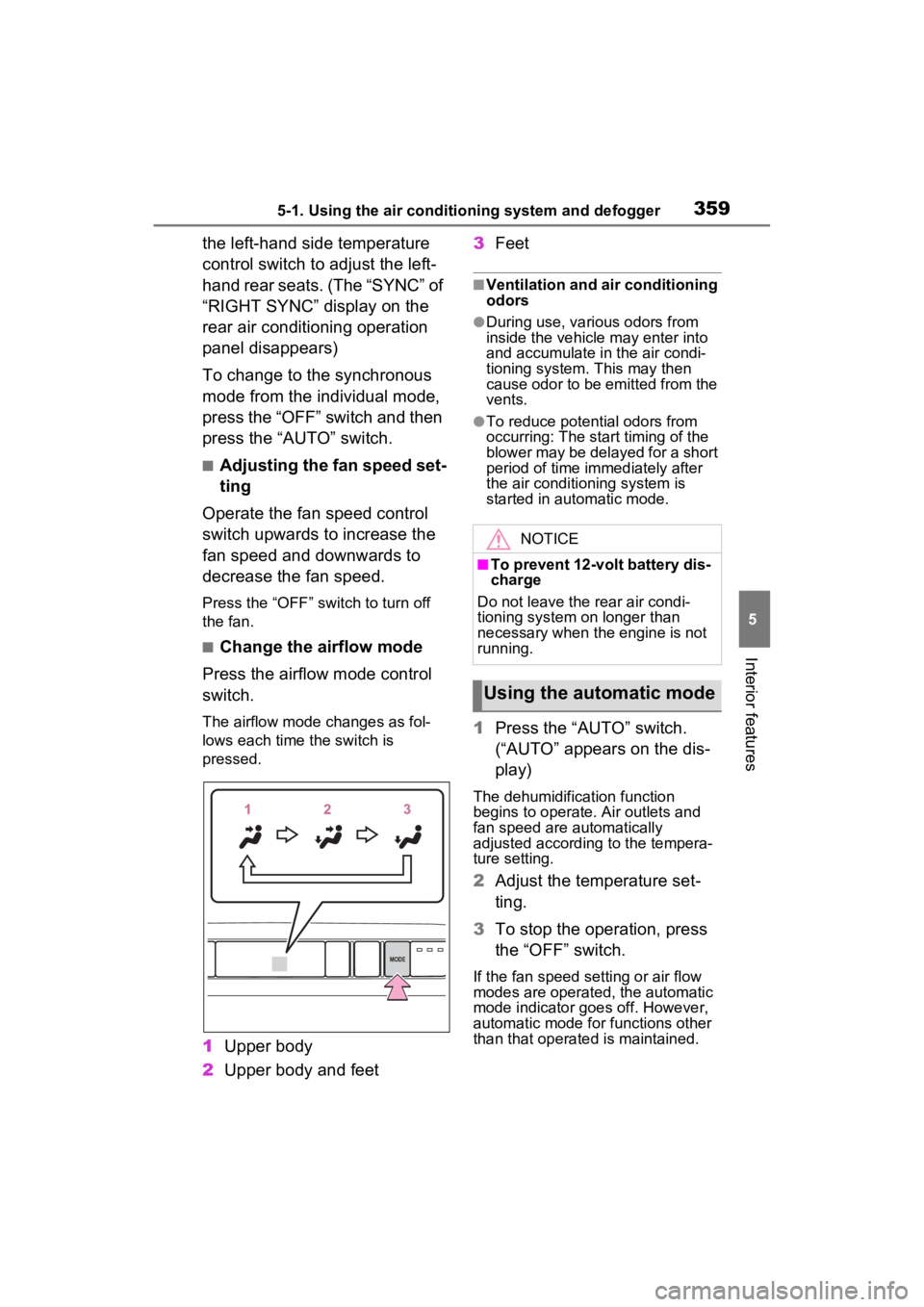
3595-1. Using the air conditioning system and defogger
5
Interior features
the left-hand side temperature
control switch to adjust the left-
hand rear seats. (The “SYNC” of
“RIGHT SYNC” display on the
rear air conditioning operation
panel disappears)
To change to the synchronous
mode from the individual mode,
press the “OFF” switch and then
press the “AUTO” switch.
■Adjusting the fan speed set-
ting
Operate the fan speed control
switch upwards to increase the
fan speed and downwards to
decrease the fan speed.
Press the “OFF” switch to turn off
the fan.
■Change the airflow mode
Press the airflow mode control
switch.
The airflow mode changes as fol-
lows each time the switch is
pressed.
1 Upper body
2 Upper body and feet 3
Feet
■Ventilation and air conditioning
odors
●During use, various odors from
inside the vehicle may enter into
and accumulate in the air condi-
tioning system. This may then
cause odor to be emitted from the
vents.
●To reduce potential odors from
occurring: The start timing of the
blower may be delayed for a short
period of time immediately after
the air conditioning system is
started in automatic mode.
1Press the “AUTO” switch.
(“AUTO” appears on the dis-
play)
The dehumidification function
begins to operate. Air outlets and
fan speed are automatically
adjusted according to the tempera-
ture setting.
2 Adjust the temperature set-
ting.
3 To stop the operation, press
the “OFF” switch.
If the fan speed se tting or air flow
modes are operated, the automatic
mode indicator goes off. However,
automatic mode for functions other
than that operated is maintained.
MODE
NOTICE
■To prevent 12-volt battery dis-
charge
Do not leave the rear air condi-
tioning system on longer than
necessary when the engine is not
running.
Using the automatic mode
Page 361 of 601
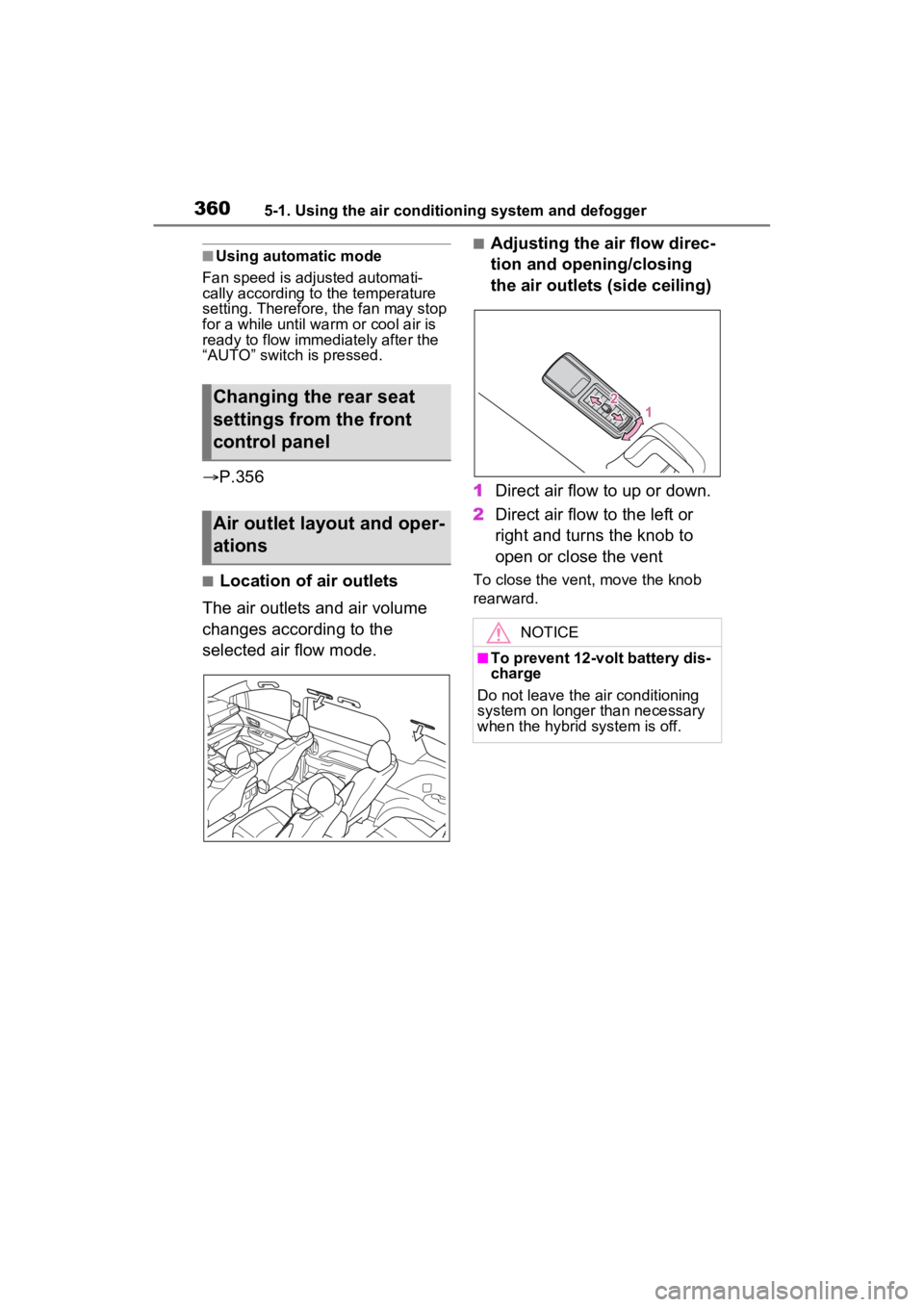
3605-1. Using the air conditioning system and defogger
■Using automatic mode
Fan speed is adjusted automati-
cally according to the temperature
setting. Therefore, the fan may stop
for a while until wa rm or cool air is
ready to flow immediately after the
“AUTO” switch is pressed.
P.356
■Location of air outlets
The air outlets and air volume
changes according to the
selected air flow mode.
■Adjusting the air flow direc-
tion and opening/closing
the air outlets (side ceiling)
1 Direct air flow to up or down.
2 Direct air flow to the left or
right and turns the knob to
open or close the vent
To close the vent, move the knob
rearward.
Changing the rear seat
settings from the front
control panel
Air outlet layout and oper-
ations
NOTICE
■To prevent 12-volt battery dis-
charge
Do not leave the air conditioning
system on longer than necessary
when the hybrid system is off.
Page 362 of 601
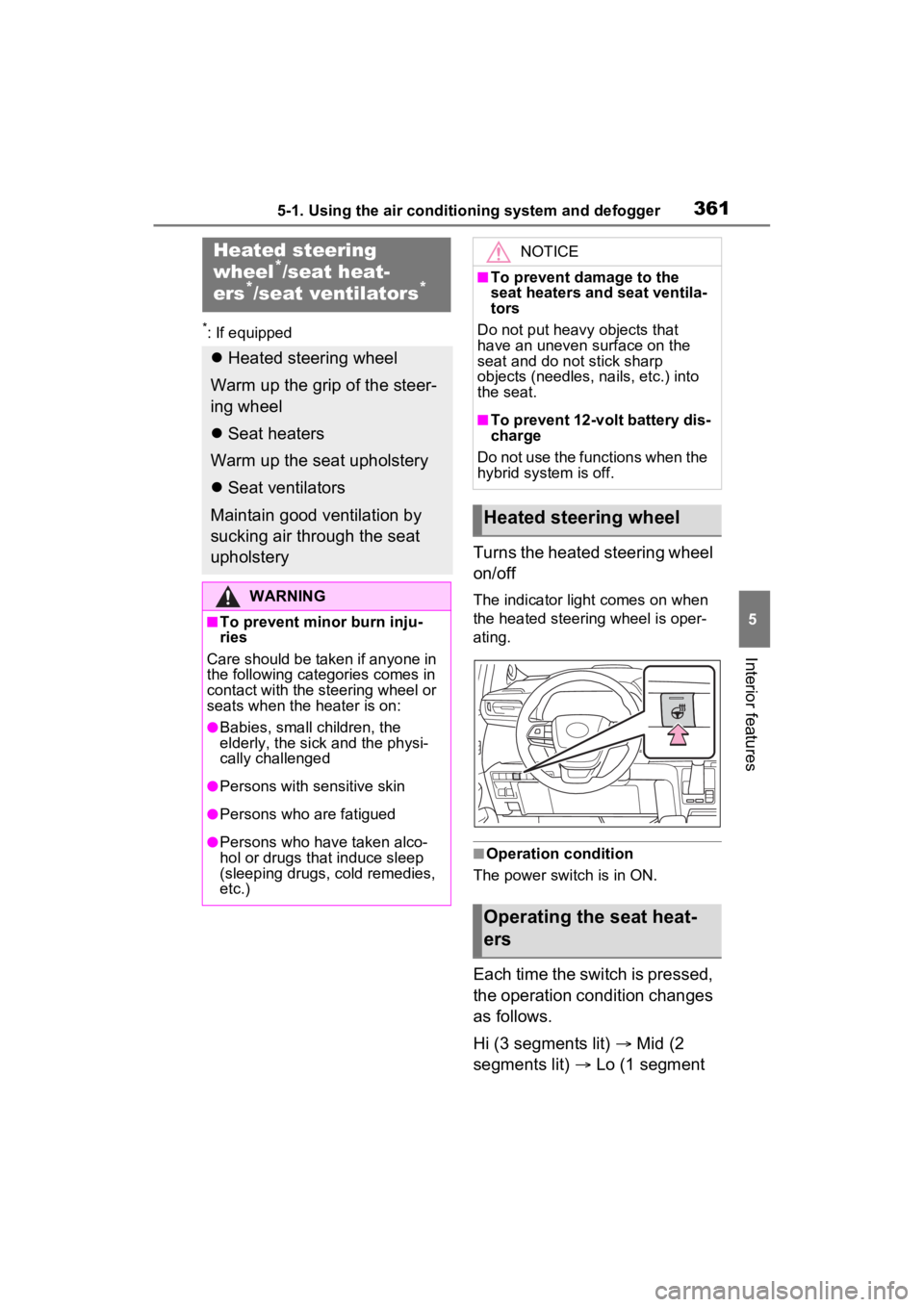
3615-1. Using the air conditioning system and defogger
5
Interior features
*: If equipped
Turns the heated steering wheel
on/off
The indicator light comes on when
the heated steering wheel is oper-
ating.
■Operation condition
The power switch is in ON.
Each time the switch is pressed,
the operation condition changes
as follows.
Hi (3 segments lit) Mid (2
segments lit) Lo (1 segment
Heated steering
wheel*/seat heat-
ers*/seat ventilators*
Heated steering wheel
Warm up the grip of the steer-
ing wheel
Seat heaters
Warm up the seat upholstery
Seat ventilators
Maintain good ventilation by
sucking air through the seat
upholstery
WARNING
■To prevent minor burn inju-
ries
Care should be taken if anyone in
the following categories comes in
contact with the steering wheel or
seats when the heater is on:
●Babies, small children, the
elderly, the sick and the physi-
cally challenged
●Persons with sensitive skin
●Persons who are fatigued
●Persons who have taken alco-
hol or drugs that induce sleep
(sleeping drugs, cold remedies,
etc.)
NOTICE
■To prevent damage to the
seat heaters and seat ventila-
tors
Do not put heavy objects that
have an uneven surface on the
seat and do not stick sharp
objects (needles, nails, etc.) into
the seat.
■To prevent 12-volt battery dis-
charge
Do not use the functions when the
hybrid system is off.
Heated steering wheel
Operating the seat heat-
ers
Page 363 of 601
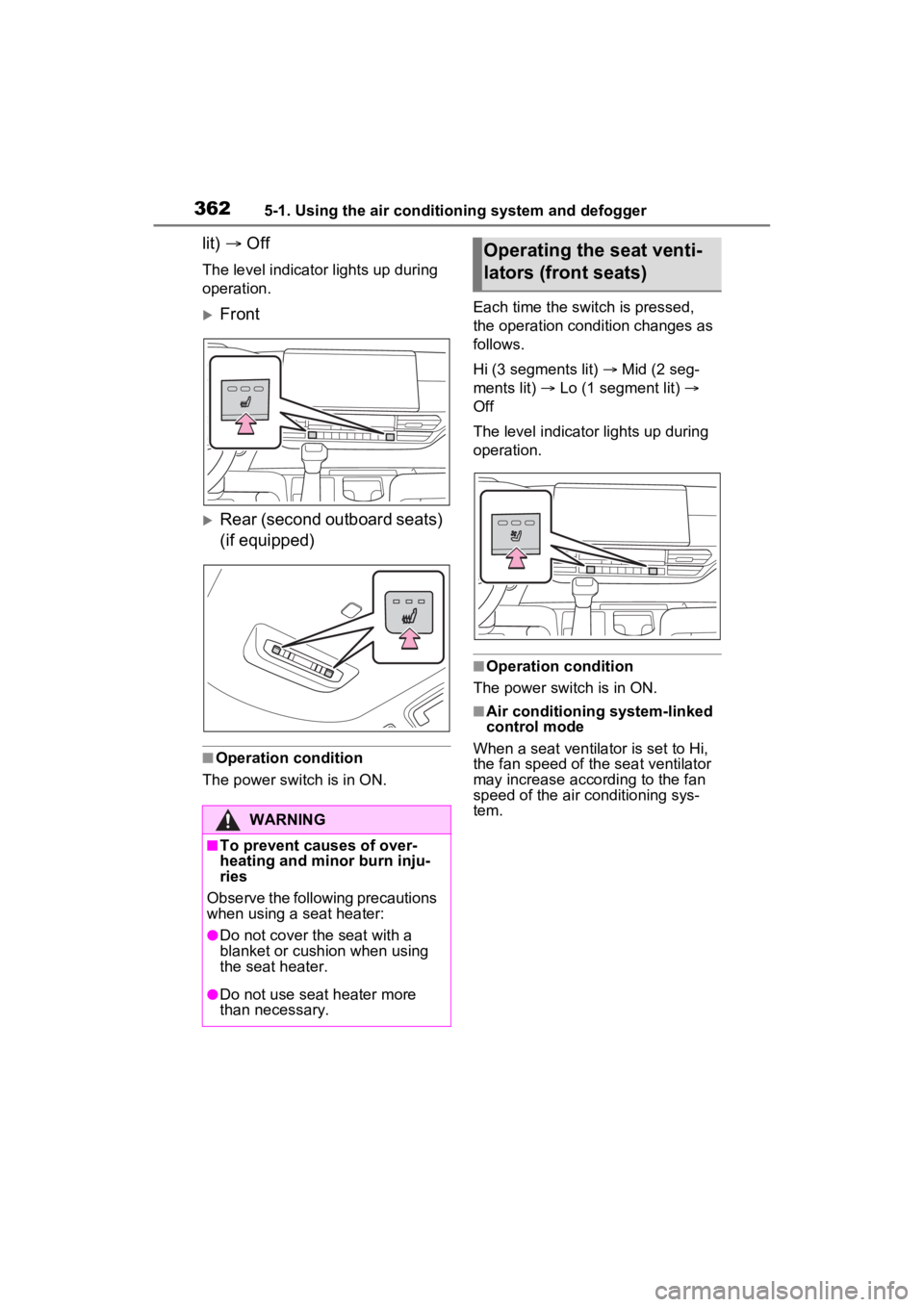
3625-1. Using the air conditioning system and defogger
lit) Off
The level indicato r lights up during
operation.
Front
Rear (second outboard seats)
(if equipped)
■Operation condition
The power swit ch is in ON. Each time the switch is pressed,
the operation condition changes as
follows.
Hi (3 segments lit)
Mid (2 seg-
ments lit) Lo (1 segment lit)
Off
The level indicato r lights up during
operation.
■Operation condition
The power switch is in ON.
■Air conditioning system-linked
control mode
When a seat ventilator is set to Hi,
the fan speed of the seat ventilator
may increase according to the fan
speed of the air conditioning sys-
tem.
WARNING
■To prevent causes of over-
heating and minor burn inju-
ries
Observe the following precautions
when using a seat heater:
●Do not cover the seat with a
blanket or cushion when using
the seat heater.
●Do not use seat heater more
than necessary.
Operating the seat venti-
lators (front seats)
Page 378 of 601
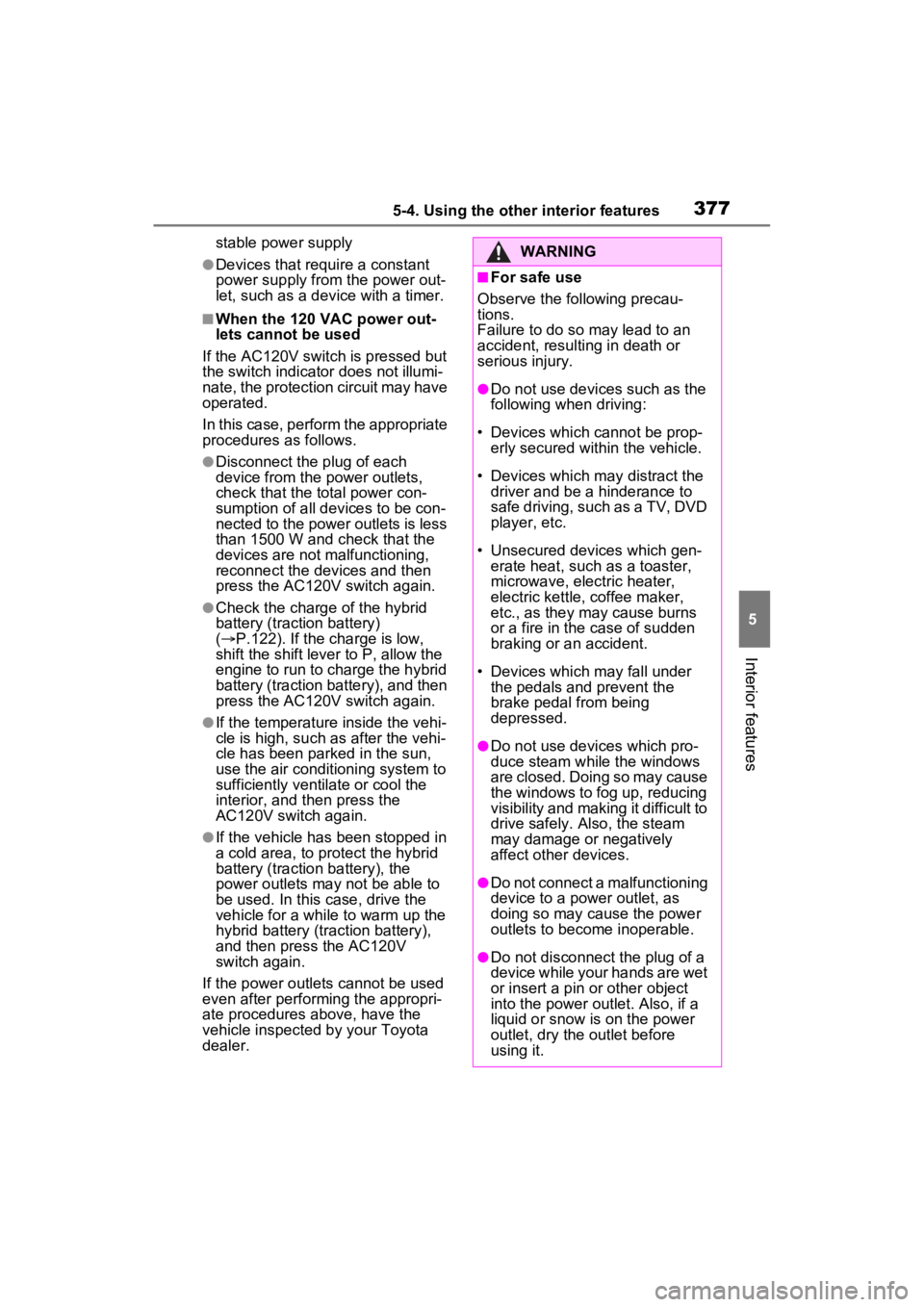
3775-4. Using the other interior features
5
Interior features
stable power supply
●Devices that require a constant
power supply from the power out-
let, such as a device with a timer.
■When the 120 VAC power out-
lets cannot be used
If the AC120V switch is pressed but
the switch indicator does not illumi-
nate, the protection circuit may have
operated.
In this case, perform the appropriate
procedures as follows.
●Disconnect the plug of each
device from the p ower outlets,
check that the total power con-
sumption of all devices to be con-
nected to the power outlets is less
than 1500 W and check that the
devices are not malfunctioning,
reconnect the devices and then
press the AC120V switch again.
●Check the charge of the hybrid
battery (traction battery)
( P.122). If the charge is low,
shift the shift lever to P, allow the
engine to run to charge the hybrid
battery (traction battery), and then
press the AC120V switch again.
●If the temperature inside the vehi-
cle is high, such as after the vehi-
cle has been park ed in the sun,
use the air conditioning system to
sufficiently ventilate or cool the
interior, and then press the
AC120V switch again.
●If the vehicle has been stopped in
a cold area, to pro tect the hybrid
battery (traction battery), the
power outlets may not be able to
be used. In this case, drive the
vehicle for a while to warm up the
hybrid battery (traction battery),
and then press the AC120V
switch again.
If the power outlets cannot be used
even after performing the appropri-
ate procedures above, have the
vehicle inspected by your Toyota
dealer.
WARNING
■For safe use
Observe the following precau-
tions.
Failure to do so may lead to an
accident, resulting in death or
serious injury.
●Do not use devices such as the
following when driving:
• Devices which cannot be prop- erly secured within the vehicle.
• Devices which may distract the driver and be a hinderance to
safe driving, such as a TV, DVD
player, etc.
• Unsecured devices which gen- erate heat, such as a toaster,
microwave, electric heater,
electric kettle, coffee maker,
etc., as they may cause burns
or a fire in the case of sudden
braking or an accident.
• Devices which may fall under the pedals and prevent the
brake pedal from being
depressed.
●Do not use devices which pro-
duce steam while the windows
are closed. Doing so may cause
the windows to fog up, reducing
visibility and making it difficult to
drive safely. Also, the steam
may damage or negatively
affect other devices.
●Do not connect a malfunctioning
device to a power outlet, as
doing so may cause the power
outlets to become inoperable.
●Do not disconnect the plug of a
device while your hands are wet
or insert a pin or other object
into the power ou tlet. Also, if a
liquid or snow is on the power
outlet, dry the outlet before
using it.